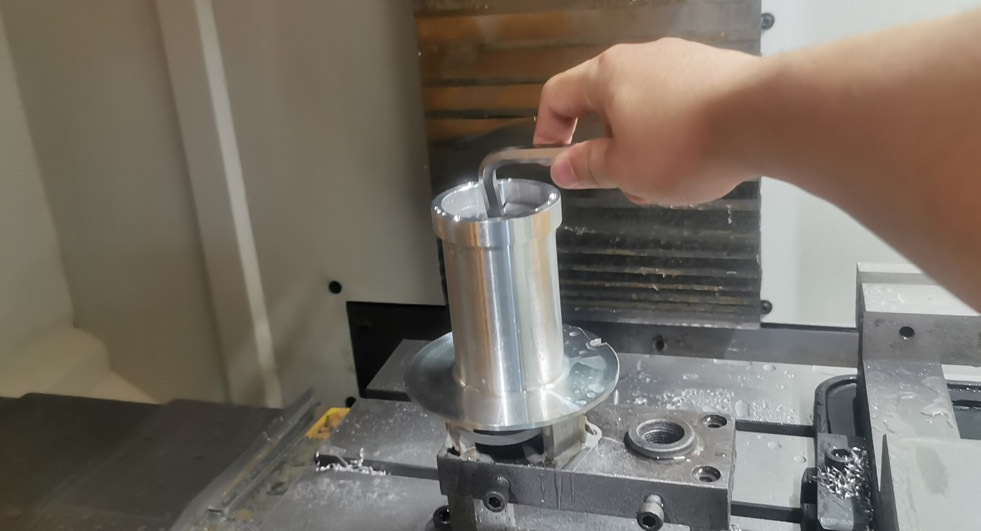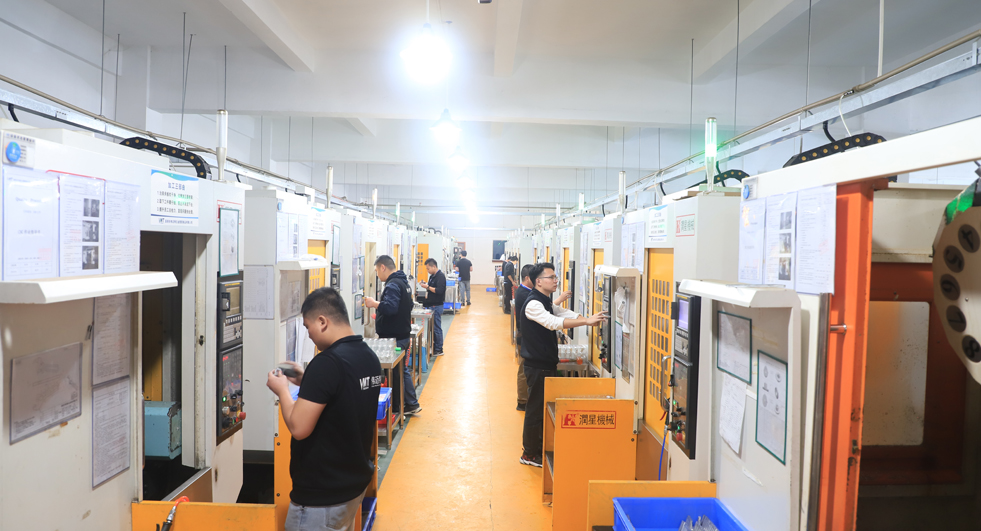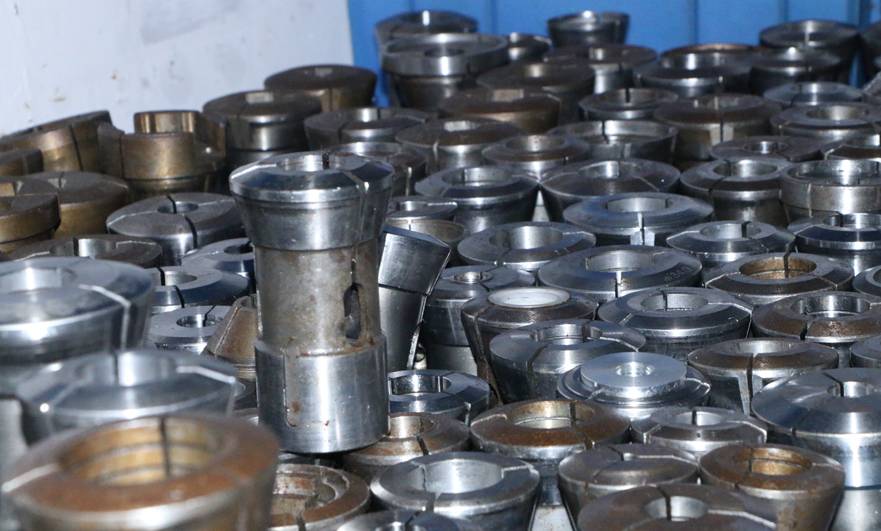1) What are the three methods of clamping CNC machining parts?
1. Clamp in the fixture;
2. Directly find the formal clip;
3. Mark the line to find the correct clip

2) What does the CNC machining process system include?
Machine tools, workpieces, fixtures, tools
3) What is the composition of the CNC machining process?
Roughing, semi-finishing, finishing, super-finishing
4) How are benchmarks classified?
1. Design basis
2. Process benchmarks: process, measurement, assembly, positioning (original additions: rough benchmarks, fine benchmarks)
5) What are the contents of CNC machining accuracy?
1. Dimensional accuracy;
2. Shape accuracy;
3. Position accuracy.
6) What are the original errors in the CNC machining process?
Principle error, positioning error, adjustment error, tool error, fixture error, machine tool spindle rotation error, machine tool guideway guide error, machine tool transmission error, force deformation of process system, thermal deformation of process system, tool wear, measurement error, residual stress of workpiece error.
7) the effect of process system stiffness on precision CNC machining accuracy (machine tool deformation, workpiece deformation)?
1. The workpiece shape error caused by the position change of the cutting force action point;
2. CNC machining errors caused by changes in cutting force;
3. CNC machining error caused by clamping force and gravity;
4. The influence of transmission force and inertia force on machining accuracy.
8) What does the guide error of the machine tool guide rail and the spindle rotation error include?
1. Guide rail: mainly includes the relative displacement error between the tool and the workpiece in the error-sensitive direction caused by the guide rail
2. Spindle: Radial circular runout, Axial circular runout, Inclination swing
9) What is the phenomenon of “error re-mapping”? What is the error remap coefficient? What are the measures to reduce error re-mapping?
Due to the change of the error deformation of the process system, it is the part of the blank error that is reflected on the workpiece. Measures: increase the number of passes, increase the rigidity of the process system, reduce the feed rate, and improve the blank accuracy.
10) Analysis of transmission error of machine tool transmission chain? Measures to reduce the transmission error of the transmission chain?
Error analysis: that is to measure the angle error Δφ of the end element of the transmission chain
Measure:
1. The fewer the number of transmission chains, the shorter the transmission chain, the smaller the Δφ, and the higher the accuracy;
2. The smaller the transmission ratio i, the smaller the transmission ratio of the head and the end;
3. Since the error of the end piece in the transmission part has the greatest influence, it should be made as accurate as possible;
4. Use a correction device.
11) How to classify precision CNC machining errors? Which errors are constant errors? Which errors are systematic errors of variable value? Which errors are random errors?
System error: (constant system error variable value system error) random error.
Constant system error: machining error caused by CNC machining principle error, manufacturing error of machine tool, tool, fixture, force deformation of process system, etc.
Variable value system error: wear of props; thermal deformation error of tools, fixtures, machine tools, etc. before thermal equilibrium.
Random errors: copying of blank errors, positioning errors, tightening errors, errors of multiple adjustments, deformation errors caused by residual stress.
12) What are the ways to ensure and improve the precision of precision CNC machining?
1. Error prevention technology: reasonable use of advanced technology and equipment to directly reduce the original error, transfer the original error, equalize the original error, and homogenize the original error.
2. Error compensation technology: On-line detection of paired parts, automatic grinding, and active control of the decisive error factors.
13) What is included in the surface geometry of CNC machining?
Geometric roughness, surface waviness, grain orientation, surface defects
14) What are the physical and chemical properties of the surface layer material?
1. Cold work hardening of surface metal
2. Metallographic deformation of surface layer metal
3. Residual stress of surface layer metal.
15) Try to analyze the factors that affect the surface roughness of CNC machining?
The roughness value is determined by the height of the cutting residual area.
Main factors: tool nose arc radius, main declination angle, secondary declination angle, and feed.
Secondary factors: increase the cutting speed, properly select the cutting fluid, properly increase the rake angle of the tool, and improve the sharpening quality of the tool.
16) Try to analyze the factors that affect the surface roughness of grinding CNC machining?
1. Geometric factors: the effect of grinding amount on surface roughness, the effect of grinding wheel particle size and grinding wheel dressing on surface roughness.
2. Influence of physical factors: plastic deformation of surface layer metal, grinding amount, selection of grinding wheel.
17) Try to analyze the factors that affect the cold work hardening of the CNC machining surface?
Influence of cutting amount Influence of tool geometry Influence of CNC machining material properties
18) What is grinding and tempering burn? What are grinding and quenching burns? What is Grinding Annealing Burn?
Tempering: If the temperature of the grinding zone does not exceed the transformation temperature of the quenched steel, but has exceeded the transformation temperature of the martensite, the martensite of the metal on the surface of the workpiece will be transformed into a tempered structure with lower hardness.
Quenching: If the temperature of the grinding zone exceeds the phase transition temperature, coupled with the cooling effect of the coolant, the surface metal will have a secondary quenched martensite structure, and the hardness is higher than the original martensite; in its lower layer, due to cooling A tempered structure with a hardness lower than that of the original tempered martensite appears slowly.
Annealing: If the temperature of the grinding zone exceeds the phase transition temperature and there is no coolant in the grinding process, the surface metal will appear annealed, and the hardness of the surface metal will drop sharply.
19) Prevention and control of CNC machining vibration
Eliminate or weaken the conditions that produce CNC machining vibration; improve the dynamic characteristics of the process system Improve the stability of the process system Use various vibration damping devices.
20) briefly describe the main difference and application of CNC machining process card, process card and process card.
Process card: CNC machining of single piece and small batch production using ordinary CNC machining methods.
Process card: medium batch CNC machining production.
Process card: high-volume CNC machining production type requires strict and meticulous organization.
21) The principle of rough benchmark selection? Refined benchmark selection principle?
Rough benchmark:
1. The principle of ensuring mutual location requirements;
2. The principle of ensuring the reasonable distribution of machining allowances for precision CNC machining surfaces;
3. The principle of facilitating workpiece clamping;
4. The principle that rough benchmarks should not be reused in general.
Precise benchmark:
1. The principle of datum coincidence;
2. Unified benchmark principles;
3. The principle of mutual benchmarks;
4. Self-base principle;
5. The principle of easy clamping.

22) What are the principles for the sequence arrangement of CNC machining?
1. First CNC machine the reference surface, and then CNC machine other surfaces;
2. In half of the cases, the surface is CNC machined first, and then the hole is CNC machined;
3. The main surface is CNC machined first, and the secondary surface is CNC machined later;
4. Arrange the roughing process first, and then arrange the finishing process.
23) How to divide the CNC machining stages? What are the benefits of dividing CNC machining stages?
CNC machining stages are divided:
1. The roughing stage, the semi-finishing stage, the finishing stage and the precision finishing stage can ensure sufficient time to eliminate thermal deformation and eliminate the residual stress caused by roughing, so as to improve the subsequent processing accuracy. In addition, when the blank is found to be defective in the roughing stage, it is not necessary to carry out the processing of the next processing stage, thereby avoiding waste. In addition, equipment can be used reasonably, low-precision machine tools are used for rough machining and precision CNC machine tools are specially used for finishing to maintain the precision level of precision CNC machine tools; human resources are reasonably arranged, and high-skilled workers are specialized in precision CNC machining. This is very important to ensure product quality and improve process level.
24) What are the factors that affect the process allowance?
1. The dimensional tolerance Ta of the previous process;
2. The surface roughness Ry and the surface defect depth Ha generated by the previous process;
3. The space error left by the previous process.
25) What does the composition of the working hour quota include?
T quota = T single piece time + t quasi-final time / n pieces
26) What are the technological ways to improve the productivity of CNC machining?
1. Shorten the basic time;
2. Reduce the overlap between auxiliary time and basic time;
3. Reduce the time for arranging the work place;
4. Reduce preparation and finishing time.
27) What are the main contents of the assembly process regulations?
1. Analyze product drawings, divide assembly units, and determine assembly methods;
2. Formulate the assembly sequence and divide the assembly process;
3. Calculate the assembly time quota;
4. Determine the technical requirements of each process assembly, quality inspection methods and inspection tools;
5. Determine the conveying method of assembling CNC machining parts and the required equipment and tools;
6. Select and design the tools, fixtures and special equipment required during the assembly process.
28) What should be considered in the assembly process of the machine structure?
1. The machine structure should be able to be divided into independent assembly units;
2. Reduce the repair and machining during assembly;
3. The machine structure should be easy to assemble and disassemble.
29) What does the assembly accuracy generally include?
1. Mutual position accuracy;
2. Mutual motion accuracy;
3. Mutual cooperation accuracy.
30) What problems should be paid attention to when looking for the assembly dimension chain?
1. The assembly dimension chain should be simplified as necessary;
2. “One piece and one link” composed of assembly dimension chain;
3. The “directivity” of the assembly dimension chain In the same assembly structure, when there are assembly accuracy requirements in different positions and directions, the assembly dimension chain should be supervised in different directions.
31) What are the methods to ensure assembly accuracy? How are the various methods applied?
1. Interchange method;
2. Selection method;
3. Modification method;
4. Adjustment method.
32) The composition and function of machine tool fixtures?
The machine tool fixture is a device for clamping the workpiece on the machine tool. Its function is to make the workpiece have a correct position relative to the machine tool and the tool, and keep this position unchanged during the CNC machining process.
The components are:
1. Positioning elements or devices;
2. Tool guiding elements or devices;
3. Clamping elements or devices;
4. Coupling elements;
5. Clamp body;
6. Other components or devices.
The main function
1. Ensure the quality of CNC machining;
2. Improve the production efficiency of CNC machining;
3. Expand the scope of machine tool technology;
4. Reduce the labor intensity of workers to ensure production safety.
33) According to the scope of fixture use, how to classify machine tool fixtures?
1. Universal fixture
2. Special fixture
3. Adjustable clamps and group clamps
4. Combined fixtures and random fixtures
34) The workpiece is positioned on a plane. What are the commonly used positioning components? And analyze the elimination degree of freedom situation.
The workpiece is positioned in a plane. Commonly used positioning components are:
1. Fixed support
2. Adjustable support
3. Self-aligning support
4. Auxiliary support
35) The workpiece is positioned with a cylindrical hole. What are the commonly used positioning components? And analyze the elimination degree of freedom situation.
The workpiece is positioned with a cylindrical hole. Commonly used positioning elements are:
1. Mandrel
2. Positioning pins
36) What are the commonly used positioning components for the positioning of the outer circular surface of the workpiece? And analyze the elimination degree of freedom situation.
The workpiece is positioned on the outer surface of the workpiece, and the commonly used positioning elements are V-shaped blocks.
37) The workpiece is positioned with “two pins on one side”, how to design two pins?
1. Determine the size and tolerance of the center distance between the two pins
2. Determine the diameter of the cylindrical pin and its tolerance
3. Determine the diamond pin width diameter and its tolerance
38) What are the two aspects of positioning error? What are the methods for calculating the positioning error?
There are two aspects of positioning error:
1. The positioning error caused by the inaccurate production of the positioning element on the workpiece positioning surface or the fixture is called the reference position error.
2. The positioning error caused by the misalignment of the workpiece process reference and the positioning reference is called the reference misalignment error.
39) The basic requirements for the design of the workpiece clamping device.
1. During the clamping process, the correct position obtained when the workpiece is positioned should be maintained.
2. The clamping force is appropriate, and the clamping mechanism should be able to ensure that the workpiece does not loosen or vibrate during the CNC machining process, and at the same time, to avoid improper deformation and surface damage of the workpiece, the clamping mechanism should generally have a self-locking effect.
3. The clamping device should be easy to operate, labor-saving and safe.
4. The complexity and automation of the clamping device should be adapted to the production batch and production method. The structural design should be simple, compact and use standardized components as much as possible.
40) What are the three elements for determining the clamping force? What are the principles for the selection of clamping force direction and action point?
The selection of the action point in the size direction and the direction of the clamping force should generally follow the following principles:
1. The direction of action of the clamping force should be conducive to the accurate positioning of the workpiece without destroying the positioning. For this reason, the main clamping force is generally required to be directed vertically to the positioning surface;
2. The direction of the clamping force should be as consistent as possible with the direction of the workpiece with high rigidity, so as to reduce the clamping deformation of the workpiece.
The direction of clamping force should be as consistent as possible with the direction of cutting force and workpiece gravity, so as to reduce the required clamping force.
1. The action point of the clamping force should be directly on the supporting surface formed by the supporting element to ensure that the positioning of the workpiece is unchanged.
2. The action point of the clamping force should be in a position with better rigidity to reduce the clamping deformation of the workpiece.
3. The action point of the clamping force should be as close as possible to the CNC machined surface to reduce the turning moment caused by the cutting force on the workpiece.
41) What are the commonly used clamping mechanisms? Focus on analyzing and mastering the wedge clamping mechanism.
1. Wedge clamping structure
2. Screw clamping structure
3. Eccentric clamping structure
4. Hinged clamping structure
5. Centering and clamping structure
6. Linkage clamping structure
42) How to classify according to the structural characteristics of drilling dies? How to classify according to the structural characteristics of drill sleeves? According to the specific connection method of the drill template and the clamp, what are the categories?
According to the common structural characteristics of the drilling die:
1. Fixed drill die
2. Rotary drill die
3. Flip drill die
4. Cover type drilling die
Structural features and classification of spool type drilling dies:
1. Fixed drill die
2. Replaceable drill die
3. Quick change drill die
The connection method of the special drill template to the clamp:
1. Fixed
2. Hinged
3. Separate
4. Hanging
43) What are the characteristics of CNC machining center machine tool clamps?

1. Simplified functions
2. Complete positioning
3. Open structure
4. Quick reset

The above is just a summary of the CNCMF CNC machining factory. If you want to know more about CNC machining, you can contact us: [email protected] to negotiate with us.